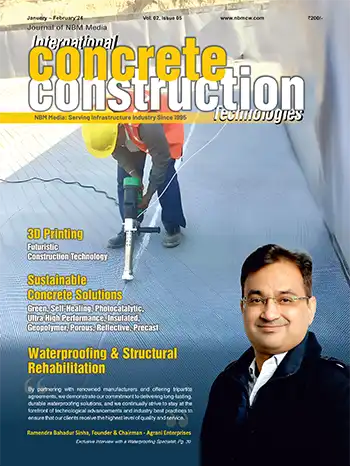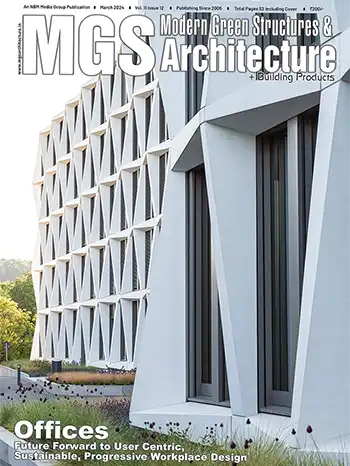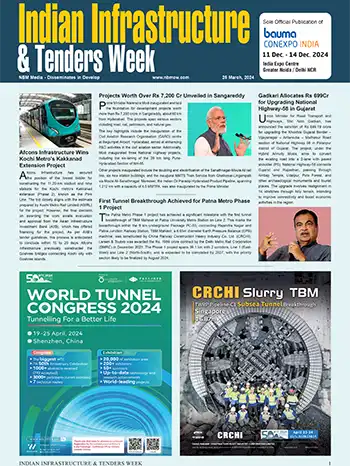Trends in Waterproofing
Stacy Byrd, Technical Services Director & Amit Bartakke, Regional sales Director – India & subcontinents, CETCO
In recent years expensive remedial work to correct failures in below-grade waterproofing systems has motivated owners and designers to seek high-performance and reliable waterproofing solutions to prevent water ingress. In some cases the remedial costs have been many times greater than the initial cost to install the waterproofing; with remedial results not successful at eliminating all of the water leaks.
The construction industry has utilized passive SBS/APP waterproofing membranes for years with general success, but recent failures have led to the development of hybrid membranes that in some cases incorporate active barrier materials for enhanced performance and reliability.
Most of the problems that arise in waterproofing are due to one or more of the following factors:
For example, waterproofing admixtures, when introduced into concrete mixes, offer some integral waterproofing capabilities. The waterproofing admixtures work within the concrete to prevent transmission of moisture on a microscopic level by affecting concrete pore structure. The issue with admixture waterproofing is that its effectiveness is limited by how well cracking is controlled. Cracking in foundation walls and slabs creates an entry point through which water can easily migrate. Contractors have found it necessary to use remedial polyurethane foam grouts to repair cracks and stop water infiltration through cast-in-place concrete cold joints. Additionally, since the admixture waterproofing material is not a separate barrier material applied to the exterior wall, surface of the foundation the project team must consider what increased level of corrosion is acceptable in the foundation walls knowing that the water is most likely going to penetrate into the structural foundation concrete wall before it can start to be stopped in cracks by the admixture waterproofing.
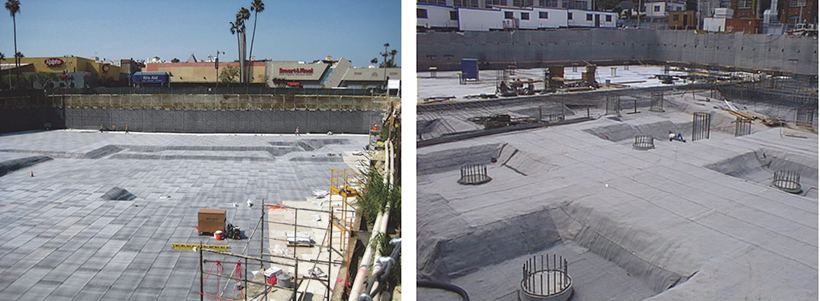
Voltex / Voltex DS waterproofing installed over substrate prior to raft slab placement.
Prior to selecting a membrane, Owners must consider their tolerance for water ingress and the appearance of water-related effects, such as efflorescence and biological growth, in the project’s below-grade spaces. Typically, the usage of the below-ground space determines the level of acceptability of water ingress. For example, the expectation for water-tightness is drastically different for a hospital than it is for a parking garage.
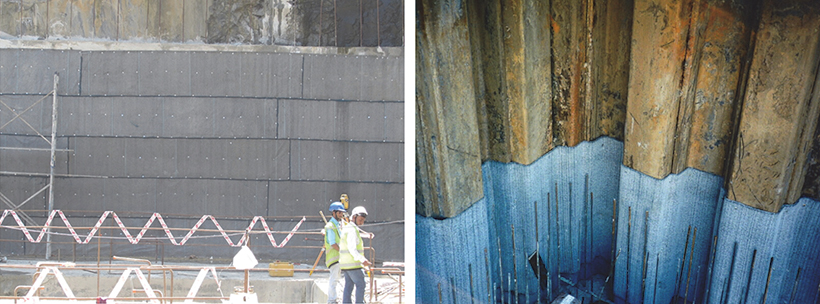
Voltex / Voltex DS waterproofing membrane installed on shoring retention wall prior to foundation wall being cast - blind-side waterproofing application.
Some sites possess the potential for differential settlement to occur for various reasons such as soil type or seismic activity. Settlement has important consequences for waterproofing membranes, since a structural slab may experience cracking. Slab cracking can potentially rupture an underslab membrane, allowing transmission of moisture up through the damaged membrane into the interior space above.
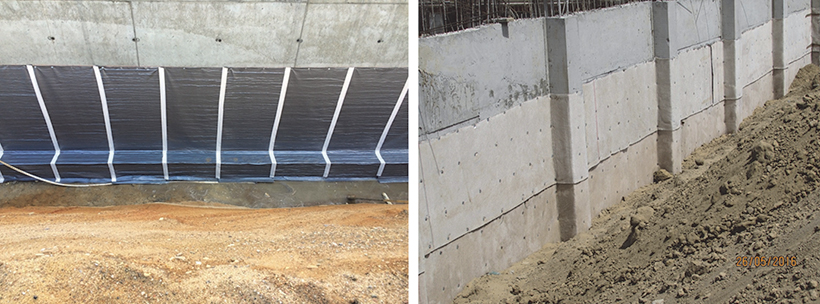
Backfilled wall waterproofing by CETCO – Voltex & Voltex DS
There are many options available when considering approaches for below-grade waterproofing. It is important that the project team consider their tolerance for risk of water ingress with regards to the foundation construction method, and geotechnical factors when determining the most appropriate waterproofing system. A primary decision factor is the construction method, which will dictate whether blind-side or positive-side waterproofing will be used in conditions where a below-grade waterproofing membrane is required. While traditional membranes have been used successfully in the past and are still viable options, innovations on the part of material manufacturers are presenting new options that compensate for limitations that have led to failures. Hybrid materials appear to create solutions for problematic installations.
The construction industry has utilized self-adhering waterproofing sheet membranes for several decades with general success, but failures and limited performance have led to new material developments. New sheet membranes introduce measures of redundancy performance by combining passive and active materials to create hybrid products. Hybridization of below-grade waterproofing membranes seeks to combine traditional materials in an effort to counter failure trends. By recognizing modes of failure in traditional membranes, new hybrid products hope to prevent failure by incorporating several material types, and thus several different failure modes, in a single membrane. The common trend among all emerging waterproofing systems is a recognized need to perform at a higher performance level.
The trend towards hybrid products originated with bentonite being combined with polyethylene membranes. The advantage of incorporating two layers of waterproofing, regardless of integration into a single membrane, is immediately apparent: two layers of protection are better than one. Combination of waterproofing materials allows the composite membrane to harness the capabilities of each layer while enhancing the performance of both through proximity of placement. CETCO used this approach in their design of Voltex DS, which consists of a polyethylene liner combined with active sodium bentonite interlocked between two geotextiles. In this case, the polyethylene membrane layer resembles traditional passive membranes, while the active bentonite layer reacts to and seals the water that circumvents the polyethylene layer. Thereby, the bentonite layer compensates for imperfections in installation and undetected minor construction damage in the polyethylene membrane.
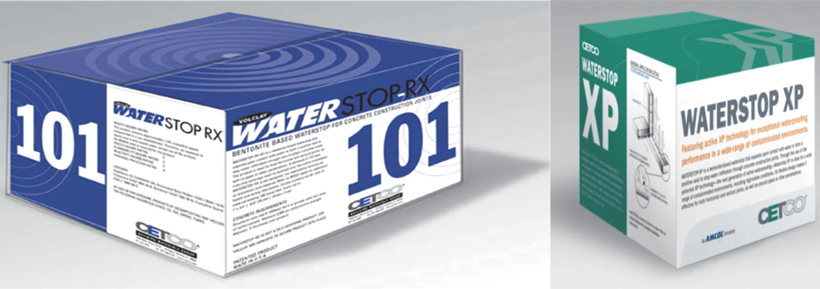
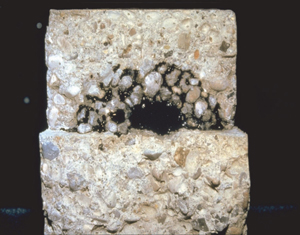
Bentonite strip Water stop RX 101 / XP expanded into poorly consolidated concrete.
Recently hydrophilic swelling strip waterstops have gained in popularity due to their ease of installation and wide application utility. Among this type of waterstop are bentonite-based products like Waterstop-RX 101 / XP by CETCO. These active hydrophilic strip bentonite waterstops swell in the presence of water to form a positive seal in the concrete construction joint to obstruct water migration through the joint. Also these strip waterstops can be installed around pipes and irregular shaped mechanical elements that may pass through the waterproofing plane; an application that cannot be accomplished with traditional PVC dumbbell waterstops.
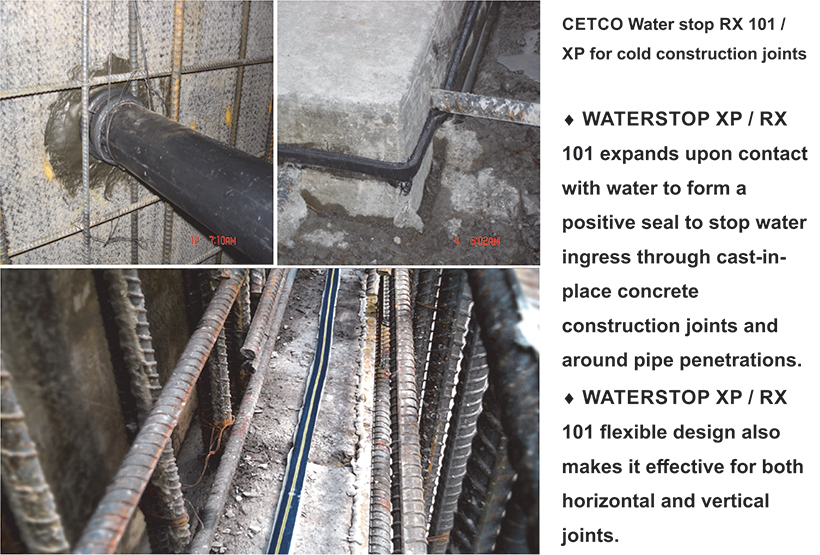
One method to improve workmanship is for the project team to implement a quality assurance program for the below-grade waterproofing that forces the waterproofing subcontractor to establish quality standards for the work. This requires, in part, that the subcontractors follow a specific set of workmanship guides established by the material manufacturer. A quality program should require the waterproofer to complete and maintain daily reports on their installation work that includes both site maps and photos. Another practice is to specify and implement a mock-up of the waterproofing installation to set the project work standard and prove that the material can be installed properly to the project conditions. Also the waterproofing subcontractor should prepare full shop drawings so that the field installer has complete understanding of the application. Finally, specify, plan and hold a pre-construction meeting with all the applicable subcontractors that will or could impact the waterproofing installation; and express to all participants the importance of the waterproofing system as it relates to the success of the project. And during the installation timely inspections by a qualified third party inspector should be conducted throughout the course of the waterproofing system installation and backfill placement.
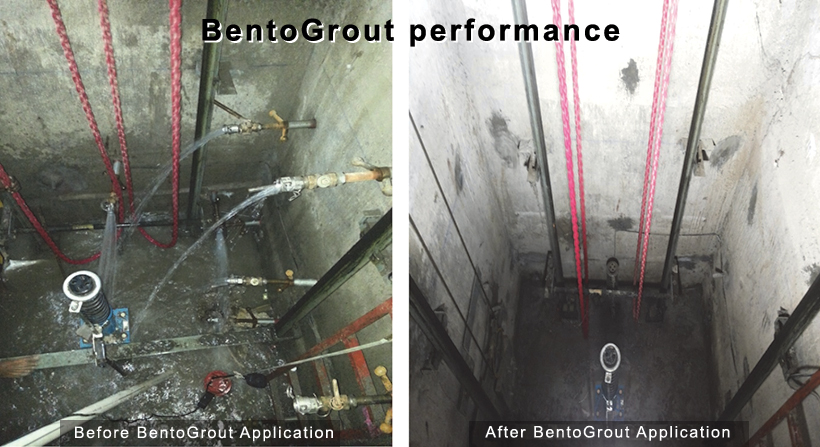 “BentoGrout remedial waterproofing grout injected to the exterior of the foundation to stop water infiltration.”
“BentoGrout remedial waterproofing grout injected to the exterior of the foundation to stop water infiltration.”
Conclusion
Numerous failures and costly repairs have pushed the construction industry to search for more reliable below-grade waterproofing solutions. Careful consideration of site conditions and construction methodologies can lead to successful selection and installation of below-grade waterproofing membranes so that future remedial work is limited. To avoid failures, new developments in waterproofing membranes, such as dual membrane hybrid systems combining passive and active materials offer the designer the ability to compensate for potential weakness in traditional waterproofing membranes. Finally, a quality assurance program should be planned and implemented to treat the waterproofing as a strategic building material for the long-term success of the project.
Author

Stacy Byrd is the Technical Services Director & Amit Bartakke Regional sales Director – India & subcontinents, a leading manufacturer of waterproofing, green roof systems, composite drainage, and water stops.
In recent years expensive remedial work to correct failures in below-grade waterproofing systems has motivated owners and designers to seek high-performance and reliable waterproofing solutions to prevent water ingress. In some cases the remedial costs have been many times greater than the initial cost to install the waterproofing; with remedial results not successful at eliminating all of the water leaks.
The construction industry has utilized passive SBS/APP waterproofing membranes for years with general success, but recent failures have led to the development of hybrid membranes that in some cases incorporate active barrier materials for enhanced performance and reliability.
Most of the problems that arise in waterproofing are due to one or more of the following factors:
- Choosing inappropriate waterproofing membranes for the wall casting methods
- Construction practices and traffic that damage the waterproofing materials after installation
- Designs and materials that are inappropriate for the site conditions
- Materials that are installed incorrectly
- Construction schedules that do not allow for proper sequence and adequate inspection of the work
- Value engineering that eliminates components of the waterproofing system or decreases the quality of the waterproofing system
For example, waterproofing admixtures, when introduced into concrete mixes, offer some integral waterproofing capabilities. The waterproofing admixtures work within the concrete to prevent transmission of moisture on a microscopic level by affecting concrete pore structure. The issue with admixture waterproofing is that its effectiveness is limited by how well cracking is controlled. Cracking in foundation walls and slabs creates an entry point through which water can easily migrate. Contractors have found it necessary to use remedial polyurethane foam grouts to repair cracks and stop water infiltration through cast-in-place concrete cold joints. Additionally, since the admixture waterproofing material is not a separate barrier material applied to the exterior wall, surface of the foundation the project team must consider what increased level of corrosion is acceptable in the foundation walls knowing that the water is most likely going to penetrate into the structural foundation concrete wall before it can start to be stopped in cracks by the admixture waterproofing.
Waterproofing Selection Factors
Selection of the waterproofing system typically depends on several key factors, such as the foundation construction method (i.e., blind-side or positive-side backfilled walls), environmental conditions, and geotechnical factors such as the potential for hydrostatic pressure. But ultimately the membrane selection may depend on the Owner’s tolerance for risk of water intrusion versus its installed cost.
Voltex / Voltex DS waterproofing installed over substrate prior to raft slab placement.
Prior to selecting a membrane, Owners must consider their tolerance for water ingress and the appearance of water-related effects, such as efflorescence and biological growth, in the project’s below-grade spaces. Typically, the usage of the below-ground space determines the level of acceptability of water ingress. For example, the expectation for water-tightness is drastically different for a hospital than it is for a parking garage.
Site Access: Positive-Side vs. Blind-Side
There are two general installation methods for below-grade waterproofing membranes, typically referred to as positive-side and blind-side (aka zero-lot line). Positive-side application of below-grade waterproofing membranes indicates the installer applies the membrane to a concrete wall surface after the forms are removed on an over-excavated site excavation; while blind-side application indicates the installation of the membrane occurs against an excavated shoring retention wall system, such as auger cast pilings, prior to pouring the basement walls. Under slab membrane placement would also be considered a blind-side application due to the construction sequencing. Waterproofing performance can vary dramatically depending on the application method and material. Positive-side waterproofing is an easier application due to the site access where the membrane can be inspected and repaired prior to backfill. Blind-side waterproofing performance has been more problematic as the placement of the concrete over the membrane does not afford the installer the ability to correct deficiencies. Thus with blind-side waterproofing it is even more crucial that good field quality assurance measures are undertaken prior to and during the concrete placement. It should be noted that membranes that are typically used for positive-side are generally note suitable for blind-side applications due to the reversed installation sequencing that must be undertaken. For example, a peel-and-stick self-adhering sheet membrane is suitable for positive-side applications but that same membrane is not suitable for under slab or blind-side applications.
Voltex / Voltex DS waterproofing membrane installed on shoring retention wall prior to foundation wall being cast - blind-side waterproofing application.
Geotechnical Selection Factors
Waterproofing product selection depends heavily upon the potential for hydrostatic conditions. If the project extends several levels below-grade, the project may encounter the water table. The ramification of placing the project into the water table is two-fold: the structural engineer will need to compensate for the additional forces and the waterproofing system will be subjected to hydrostatic pressure continuously or at a minimum intermittently. The requirements for membrane performance predictably increase when placed in the water table, and hydrostatic pressure exacerbates any construction defects.Some sites possess the potential for differential settlement to occur for various reasons such as soil type or seismic activity. Settlement has important consequences for waterproofing membranes, since a structural slab may experience cracking. Slab cracking can potentially rupture an underslab membrane, allowing transmission of moisture up through the damaged membrane into the interior space above.

Backfilled wall waterproofing by CETCO – Voltex & Voltex DS
Hybrid Waterproofing Materials
To avoid failures and water leaks, new developments in waterproofing membranes such hybrid systems offer designers the ability to compensate for potential weakness in the waterproofing materials with regards to the site conditions and construction method. Below-grade spaces offer few choices for repair due to inaccessibility, and the addition of new waterproofing materials are a welcome addition to the industry.There are many options available when considering approaches for below-grade waterproofing. It is important that the project team consider their tolerance for risk of water ingress with regards to the foundation construction method, and geotechnical factors when determining the most appropriate waterproofing system. A primary decision factor is the construction method, which will dictate whether blind-side or positive-side waterproofing will be used in conditions where a below-grade waterproofing membrane is required. While traditional membranes have been used successfully in the past and are still viable options, innovations on the part of material manufacturers are presenting new options that compensate for limitations that have led to failures. Hybrid materials appear to create solutions for problematic installations.
The construction industry has utilized self-adhering waterproofing sheet membranes for several decades with general success, but failures and limited performance have led to new material developments. New sheet membranes introduce measures of redundancy performance by combining passive and active materials to create hybrid products. Hybridization of below-grade waterproofing membranes seeks to combine traditional materials in an effort to counter failure trends. By recognizing modes of failure in traditional membranes, new hybrid products hope to prevent failure by incorporating several material types, and thus several different failure modes, in a single membrane. The common trend among all emerging waterproofing systems is a recognized need to perform at a higher performance level.
The trend towards hybrid products originated with bentonite being combined with polyethylene membranes. The advantage of incorporating two layers of waterproofing, regardless of integration into a single membrane, is immediately apparent: two layers of protection are better than one. Combination of waterproofing materials allows the composite membrane to harness the capabilities of each layer while enhancing the performance of both through proximity of placement. CETCO used this approach in their design of Voltex DS, which consists of a polyethylene liner combined with active sodium bentonite interlocked between two geotextiles. In this case, the polyethylene membrane layer resembles traditional passive membranes, while the active bentonite layer reacts to and seals the water that circumvents the polyethylene layer. Thereby, the bentonite layer compensates for imperfections in installation and undetected minor construction damage in the polyethylene membrane.
Waterstops
Another trend is the use of hydrophilic waterstops in the concrete construction joints as a back-up to the waterproofing membrane installed on the exterior surface of the below-grade structure. Waterstop is a material that is embedded in the concrete, across the concrete joint, to obstruct the passage of water through the joint. A waterstop installed in concrete joints is an important component of an overall waterproofing design. Use of a waterstop with a waterproofing membrane is considered a belt-and-suspenders approach to provide a dry basement. This is a common practice to waterproofing design because if for some reason water is able to circumvent the membrane the waterstop is in position to obstruct the water in the most likely place the water leak can occur – through the concrete cold joint.

Bentonite strip Water stop RX 101 / XP expanded into poorly consolidated concrete.
Recently hydrophilic swelling strip waterstops have gained in popularity due to their ease of installation and wide application utility. Among this type of waterstop are bentonite-based products like Waterstop-RX 101 / XP by CETCO. These active hydrophilic strip bentonite waterstops swell in the presence of water to form a positive seal in the concrete construction joint to obstruct water migration through the joint. Also these strip waterstops can be installed around pipes and irregular shaped mechanical elements that may pass through the waterproofing plane; an application that cannot be accomplished with traditional PVC dumbbell waterstops.

Remedial Waterproofing Trends
With regards to remedial waterproofing, cement grouts injected to the exterior side of a foundation wall and polyurethane grouts injected directly within the cracks of the foundation wall have been used extensively; both with varying degrees of success. The limitation with polyurethane grouts are that they are injected through a drilled hole that intersects each crack within the wall and may not actually prevent the water from entering the wall. The primary limitation for cement grout is that when it is injected it can be contaminated with the soils around the structure to make it more permeable as well as weaken its bond potential to the exterior surface of the existing concrete. To address these problems there is another remedial injection grout produced with bentonite. The bentonite-grout is injected through a drilled hole to the exterior side of the foundation wall where it fills voids and coats the exterior surface of the concrete. Unlike cement grouts, the bentonite-grout forms a strong adhesion to the outside surface of the concrete that remains plastic and pliable to maintain a positive seal. It is this plastic long term bond properties that separates it from cement grouts that will cure rigid and simply form a concrete cold joint with the existing concrete. Also for some applications the bentonite-grout can be used in conjunction with the polyurethane grout, whereby the polyurethane is injected into the wall cracks and then the bentonite-based grout is injected to the exterior to coat the wall to eliminate water infiltration into the wall to stop further corrosion of the structural foundation. For shallow depths, the bentonite-grout can be injected through a trimie pipe manually placed without excavating.Importance of Quality Assurance
Contractors may have the most important role with regards to waterproofing – the installation. Waterproofing should be treated as a strategic building material for the long-term success of the project. For waterproofing, proper design, installation and concreting practices must be followed. Additionally, it is very important that the installer’s crew be well trained in the proper installation of the material. If the installer’s crew is not properly trained with regards to the installation of the material, it simply may not matter which product is selected.One method to improve workmanship is for the project team to implement a quality assurance program for the below-grade waterproofing that forces the waterproofing subcontractor to establish quality standards for the work. This requires, in part, that the subcontractors follow a specific set of workmanship guides established by the material manufacturer. A quality program should require the waterproofer to complete and maintain daily reports on their installation work that includes both site maps and photos. Another practice is to specify and implement a mock-up of the waterproofing installation to set the project work standard and prove that the material can be installed properly to the project conditions. Also the waterproofing subcontractor should prepare full shop drawings so that the field installer has complete understanding of the application. Finally, specify, plan and hold a pre-construction meeting with all the applicable subcontractors that will or could impact the waterproofing installation; and express to all participants the importance of the waterproofing system as it relates to the success of the project. And during the installation timely inspections by a qualified third party inspector should be conducted throughout the course of the waterproofing system installation and backfill placement.
 “BentoGrout remedial waterproofing grout injected to the exterior of the foundation to stop water infiltration.”
“BentoGrout remedial waterproofing grout injected to the exterior of the foundation to stop water infiltration.”Conclusion
Numerous failures and costly repairs have pushed the construction industry to search for more reliable below-grade waterproofing solutions. Careful consideration of site conditions and construction methodologies can lead to successful selection and installation of below-grade waterproofing membranes so that future remedial work is limited. To avoid failures, new developments in waterproofing membranes, such as dual membrane hybrid systems combining passive and active materials offer the designer the ability to compensate for potential weakness in traditional waterproofing membranes. Finally, a quality assurance program should be planned and implemented to treat the waterproofing as a strategic building material for the long-term success of the project.
Author

Stacy Byrd is the Technical Services Director & Amit Bartakke Regional sales Director – India & subcontinents, a leading manufacturer of waterproofing, green roof systems, composite drainage, and water stops.
NBM&CW April 2017















